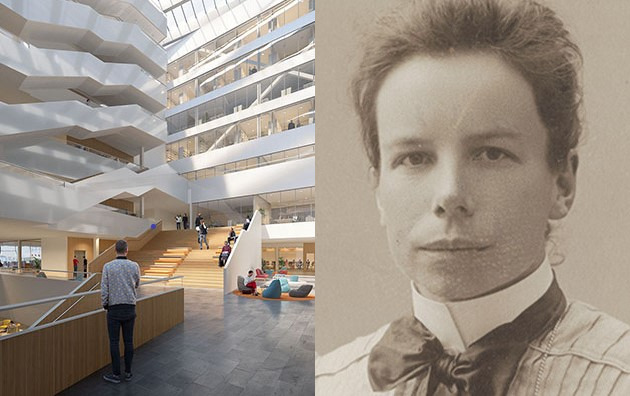In May 2022 Nya Ångström or Building 10 at Polacksbacken will be officially opened. The names of nine of the building’s lecture halls and meeting rooms have now been decided on. The Vice-Chancellor established the names proposed by the Faculty of Science and Technology for four lecture halls, each seating over 100 people, and five bookable meeting rooms.
The rooms have been named after important people in science and technology – many of them women who have carried out important research:
Lecture halls:
Eva von Bahr, seats 320
Sonja Lyttkens, seats 180
Heinz-Otto Kreiss, seats 180
Evelyn Sokolowski, seats 120
Meeting rooms:
Ada Lovelace, 14 people
Elsa-Karin Boestad-Nilsson, 14 people
Gustav de Laval, 14 people
Lise Meitner, 8 people
The faculty room will retain the name ‘Fakultetsrummet’
Below are the justifications for the proposed names:
Eva von Bahr, 1874-1962
Physicist at Uppsala University and the first woman in Sweden to be appointed a docent in physics after having publicly defended her doctoral thesis and gained the highest grade in 1908. Her thesis concerned the absorption of infrared rays in gases. She worked under Knut Ångström, but as a woman she was not allowed to continue teaching after his death. Eva was refused a professorship in Uppsala and at Chalmers University of Technology, so she applied for a position in Germany, where she continued her important studies of absorption spectra.
Sonja Lyttkens, 1919-2014
Mathematician who worked at Uppsala University. The first woman to hold a lectureship in mathematics at a Swedish university, becoming a docent in 1957 and a senior lecturer in 1963. She was a highly respected inspektor (chair) of the Kalmar Nation, and subsequently became the Head of the Department of Mathematics. She was also committed to the work of improving the situation of women in academia, including working with a network that sought to encourage young women to study mathematics.
Heinz-Otto Kreiss, 1930-2015
Uppsala University’s first Professor of Information Processing. He put Uppsala on the global map as regards numerical analysis and computational science, and that is why Scientific Computing and IT at Uppsala University still have a strong position internationally. He received the John von Neumann Lecture Prize in applied mathematics in 2003. This prize, established by the Society for Industrial and Applied Mathematics (SIAM), is perhaps the most highly regarded prize in applied mathematics. He was awarded the US National Academy of Sciences’ prize in applied mathematics and numerical analysis in 2002.
Evelyn Sokolowski, 1933-2019
Physicist who worked at Uppsala University.
She worked with Kai Siegbahn and produced findings on the chemical shift – the work for which Kai received the Nobel Prize. After her work in Siegbahn’s group, she chose to begin working in nuclear technology, which was then in its infancy in Sweden.
Ada Lovelace, 1815-1852
British mathematician often described as the first programmer. Worked with a mechanical computer – the Analytical Engine – together with Charles Babbage. The programming language ADA was named after Ada Lovelace in 1970 – a language originally designed for embedded systems and real-time programming.
Elsa-Karin Boestad-Nilsson, 1925-2020
Sweden’s first female programmer, who gained a Bachelor’s degree following studies in mathematics and physics. Worked on calculations at the Swedish National Defence Research Institute, later Head of the calculations group. She programmed the first two Swedish computing machines: BARK and BESK. Elsa-Karin also worked to promote gender equality and was active within the Fredrika Bremer förbundet (an association for promoting equality between men and women).
Gustav de Laval, 1845-1913
Swedish engineer and inventor. Gustaf de Laval publicly defended his doctoral thesis in chemistry at Uppsala University in 1872, was granted a total of 92 Swedish patents and started 37 companies. His most important inventions include the cream separator, a steam turbine, the de Laval nozzle and the milking machine.
Lise Meitner, 1878-1968
Austrian physicist who did pioneering work in radioactivity and nuclear physics. Did not get to share the Nobel Prize with Otto Hahn, despite her being involved in launching the nuclear-fission hypothesis. Meitner was friends with Eva von Bahr and lived in Sweden from 1938 to 1960.
